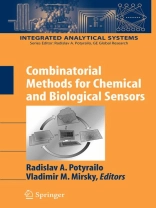Chemical sensors are in high demand for applications as varied as water pollution detection, medical diagnostics, and battlefield air analysis. Designing the next generation of sensors requires an interdisciplinary approach. The book provides a critical analysis of new opportunities in sensor materials research that have been opened up with the use of combinatorial and high-throughput technologies, with emphasis on experimental techniques. For a view of component selection with a more computational perspective, readers may refer to the complementary volume of Integrated Analytical Systems edited by M. Ryan et al., entitled “Computational Methods for Sensor Material Selection”.
Table of Content
Benefits of Combinatorial Approaches to Sensor Problems.- to Combinatorial Methods for Chemical and Biological Sensors.- Main Concepts of Chemical and Biological Sensing.- Self-Assembled Monolayers and Nanoparticles.- Self-Assembled Monolayers with Molecular Gradients.- Combinatorial Libraries of Fluorescent Monolayers on Glass.- High-Throughput Screening of Vapor Selectivity of Multisize Cd Se Nanocrystal/Polymer Composite Films.- Molecular Imprinting.- Computational Design of Molecularly Imprinted Polymers.- Experimental Combinatorial Methods in Molecular Imprinting.- Biological Receptors.- Combinatorially Developed Peptide Receptors for Biosensors.- Combinatorial Libraries of Arrayable Single-Chain Antibodies.- A Modular Strategy for Development of RNA-Based Fluorescent Sensors.- Inorganic Gas-Sensing Materials.- Impedometric Screening of Gas-Sensitive Inorganic Materials.- Design of Selective Gas Sensors Using Combinatorial Solution Deposition of Oxide Semiconductor Films.- Electrochemical Synthesis of Sensing Materials.- Combinatorial Development of Chemosensitive Conductive Polymers.- Robotic Systems for Combinatorial Electrochemistry.- Optical Sensing Materials.- Combinatorial Chemistry for Optical Sensing Applications.- High Throughput Production and Screening Strategies for Creating Advanced Biomaterials and Chemical Sensors.- Diversity-Oriented Fluorescence Library Approach for Novel Sensor Development.- Construction of a Coumarin Library for Development of Fluorescent Sensors.- Mining of New Knowledge on Sensing Materials.- Determination of Quantitative Structure–Property Relationships of Solvent Resistance of Polycarbonate Copolymers Using a Resonant Multisensor System.- Computational Approaches to Design and Evaluation of Chemical Sensing Materials.-Outlook.- Combinatorial Methods for Chemical and Biological Sensors: Outlook.
Language English ● Format PDF ● Pages 494 ● ISBN 9780387737133 ● File size 9.3 MB ● Editor Radislav A. Potyrailo & Vladimir M. Mirsky ● Publisher Springer New York ● City NY ● Country US ● Published 2009 ● Downloadable 24 months ● Currency EUR ● ID 2145830 ● Copy protection Social DRM












